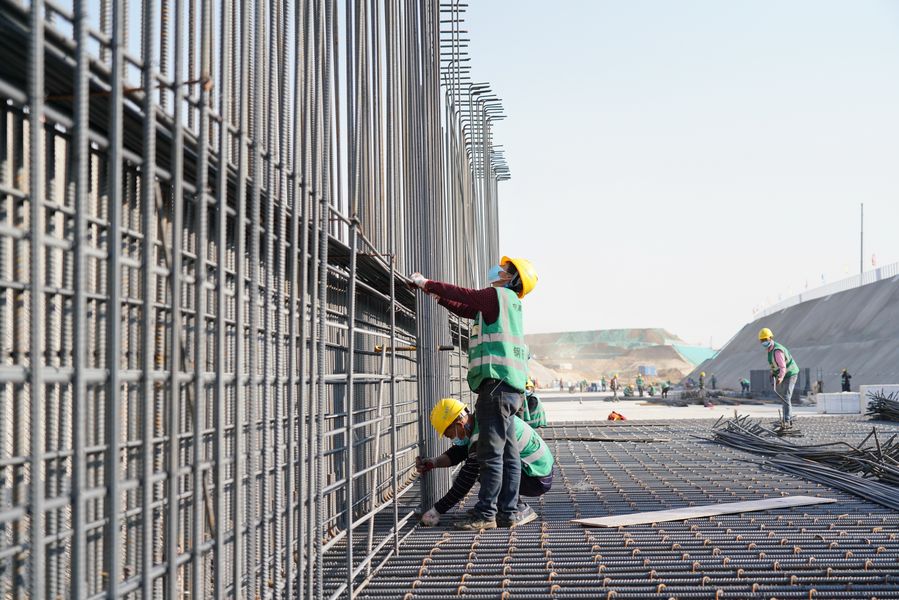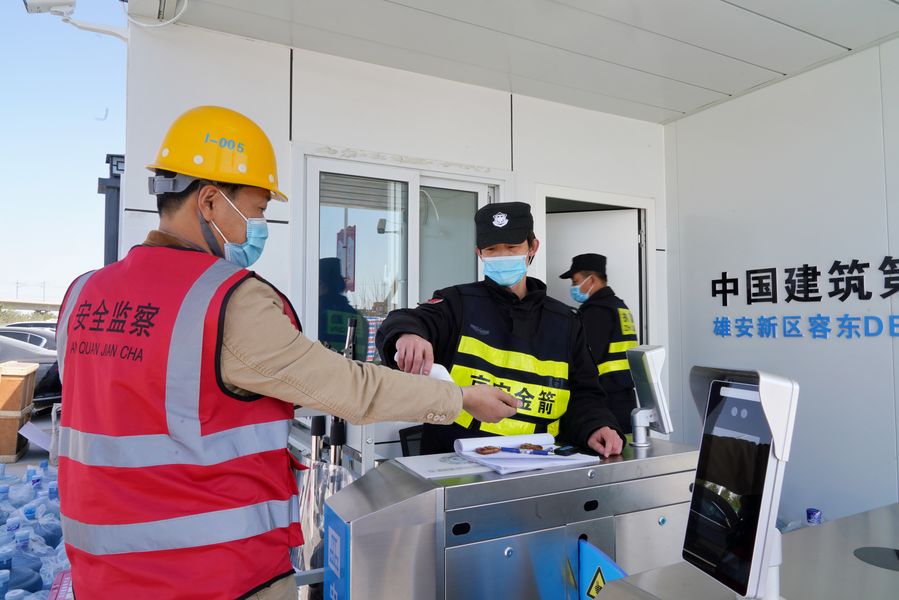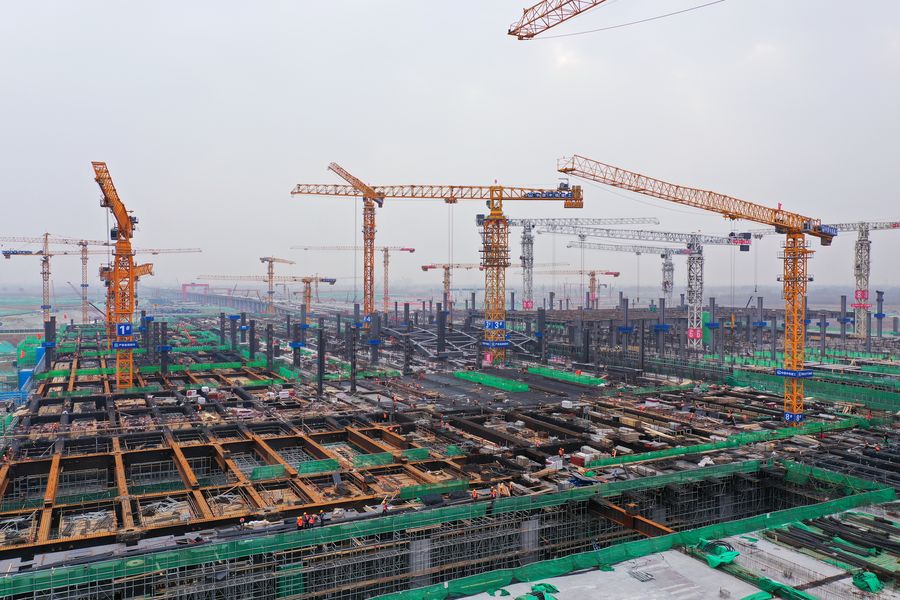As the outbreak of the novel coronavirus has been basically contained in China, the construction of Xiongan, often billed as China's "city of the future," has resumed in an orderly manner.
by Xinhua writers Lyu Qiuping, Sun Jie and Chen Zhonghua
SHIJIAZHUANG, March 31 (Xinhua) -- In the foundation pit roughly the width of a soccer field, excavators were digging and cranes were loading in rebars.
The pit, which stretches several kilometers, is an underground project to lay pipelines and water, power and gas infrastructure in Xiongan, a green city featuring innovative development in north China's Hebei Province.
As the COVID-19 epidemic eases in China and work and production is resuming gradually, the construction of Xiongan New Area has also gained steam in an orderly manner.
On April 1, 2017, China announced plans to establish Xiongan New Area, located about 100 km southwest of Beijing, with the aim of building the area -- spanning Rongcheng, Anxin and Xiongxian counties -- into a national model of high-quality development and a new engine for the modern economic system.
Wearing a helmet and a mask, Chen Jie was busy installing rebars together with hundreds of his co-workers in the foundation pit in the Rongdong area, Rongcheng County.
Stranded by the epidemic in his hometown in neighboring Henan Province during the prolonged Chinese New Year holiday, Chen put himself in self-isolation for 14 days before returning to his post in Xiongan on Feb. 12.
"While sheltering at home, I reported my body temperature every day. After going back to work, I stayed at the 'yellow zone' for another 14 days," he said.

Workers install rebars at the construction site of the Rongdong underground project in Xiongan New Area, north China's Hebei Province, March 17, 2020. (Xinhua/Mu Yu)
To prevent cross-infection, the local administration has divided the living and working areas of the key construction projects into colored zones to accommodate workers according to their infection risks.
Workers returning by means of public transport were put in the red zone and those coming back by private cars or charter buses in the yellow zone, both for two weeks, according to Gao Baozhuan, a project manager of the China Construction Eighth Engineering Division Corp., the constructor of the Rongdong project.
Local workers and those who did not go home for the holiday were assigned to the green zone, and the red and yellow zones would turn green if no infection case was spotted in 14 days, Gao said.
To date, Xiongan New Area, home to 1.2 million residents, has reported no confirmed or suspected cases of novel coronavirus disease.
As of Monday, more than 58,000 workers have returned to their posts at Xiongan, with the construction of 78 projects and the operation of over 1,000 companies resumed.

A worker has his body temperature measured at a construction site of the Rongdong underground project in Xiongan New Area, north China's Hebei Province, March 19, 2020. (Xinhua/Yang Shiyao)
FROM BLUEPRINT TO REALITY
According to Gao, the Rongdong underground project will contain not only pipelines but also a logistic passageway, allowing trucks to traverse the urban area in the daytime. A robot will also be able to run through for automatic pipeline inspections.
Often billed as China's "city of the future," Xiongan has been designed to become a zone for innovation, a digital city synchronized with a brick-and-mortar one, and a livable and business-friendly area.
As planned, Xiongan will basically develop into a modern city that is green, intelligent and livable, with relatively strong competitiveness and harmonious human-environment interaction by 2035.
More than 1,000 Chinese and foreign experts and 2,500 specialists have joined in the planning over the past three years before the construction started.
Rongdong, a 13-square-km area that is expected to be home to 170,000 people, is within the 38-square-km start-up area of Xiongan.
According to a development plan approved last year, the start-up area will be part of the Xiongan city proper, which will cover 198 square km. Designed for taking over Beijing's functions nonessential to its role as the national capital, the city proper will be a new home for Beijing's colleges, hospitals, business headquarters, and financial and public institutions.
At the construction site of a high school, concrete has been poured on the second floor of the building.
The school will be a branch of Beijing No. 4 High School, one of the most prestigious schools in Beijing.
"While ensuring workers' safety amid the epidemic, we have resumed orderly construction," said Chen Hao, manager of the project with the Beijing Urban Construction Group, adding that the campus will be ready by September 2021 for the new semester.

Aerial photo taken on March 17, 2020 shows the construction sites of Beijing No.4 High School and Beijing Shijia Primary School in Xiongan New Area, north China's Hebei Province. (Xinhua/Mu Yu)
In Zangang Township, some 10 km away from the county seat of Xiongxian, dozens of piling machines and cranes roared at the construction site of the Xiongan high-speed railway station, the first major transport project of the area.
Now that the rail-bearing floor has been finished, the bridge and the steel roof of the station house will soon be lifted, said Miao Shengguo, a Party official with the station project from the China Railway No. 12 Engineering Group.
Miao said some 3,300 workers had returned to their posts, most of whom arrived in charter buses or private cars.
"The epidemic has affected our progress, but we are racing against the clock to catch up," Miao said.
Travel time from Beijing to Xiongan by high-speed train will be shortened to only 30 minutes when the station is operational by the end of this year as planned.

Aerial photo taken on March 25, 2020 shows the construction site of Beijing-Xiongan intercity railway's Xiongan Station in Xiongan New Area, north China's Hebei Province. (Xinhua/Yang Shiyao)
GREEN MODEL
In the northern part of Xiongan, construction of a green horticultural park started in March, which will last about 16 months.
"With the theme of 'ecological Xiongan,' the 1,787-hectare park will be an important greenbelt and water conservation area," said Peng Xugeng, deputy general manager with the ecological construction company of the state-owned China Xiongan Group.
By the end of 2019, Xiongan had planted 14 million trees covering an area of 20,700 hectares, with another 6,670 hectares planned this year.
Local villager Gao Jianxun, who used to work in a nearby city, has become a forest ranger.
"Pheasants, hares and hedgehogs have become common, and the lizards that were rare in recent years have returned as well," said Gao, 51.

Aerial photo taken on March 19, 2020 shows a forestation project in Xiongan New Area, north China's Hebei Province. (Xinhua/Yang Shiyao)
Together with the wetland of Baiyangdian, 70 percent of Xiongan New Area will be covered with water or trees, according to the development plan.
Qi Ming, of the wetland management department of the natural resources bureau of Anxin County, said the Baiyangdian wetland has become a habitat for great bustards, a top-level national endangered species, to pass the winter.
The green model of Xiongan has also attracted businesses across the country to move in.
To date, a total of 2,184 enterprises have registered in the area, including 1,670 from Beijing.
Hi-tech company Eye Cool moved its headquarters from Beijing to Xiongan in 2018.
The company has participated in the construction of many AI-related projects, such as security and payment systems based on facial recognition.
Wang Shuqi, marketing director of the company, said Xiongan had the ideal environment for start-ups like "a piece of blank paper on which anything can be drawn."
"With green artificial intelligence widely adopted in every aspect of life in Xiongan, I believe people will embrace a safer, better and more convenient future life," she said.
(Cao Guochang and Gao Bo contributed to the story)
(Video reporters: Luo Xuefeng, Yang Shiyao, Mu Yu and Yang Zhirun; Video editor: Zheng Xin)■



